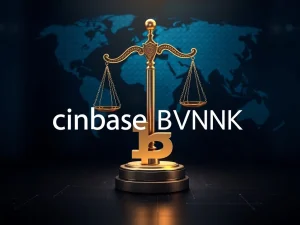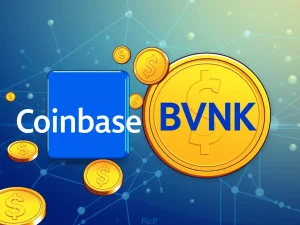Revolutionary Coinbase x402: Unlocking Crypto Payments Over HTTP for AI & APIs

Imagine a future where AI agents, apps, and APIs can instantly pay each other for data and services, seamlessly integrated into the very fabric of the internet. This might sound like science fiction, but thanks to Coinbase, it’s rapidly becoming a reality with the introduction of their groundbreaking Coinbase x402 protocol.
What is HTTP 402, and Why Does Coinbase x402 Revive It?
The internet, built decades ago, wasn’t designed for machines to pay machines. While we’ve added layers for e-commerce, they typically involve human interaction, redirects, and complex systems. The original architects of the web foresaw the need for protocol-level payments, leaving a placeholder: the HTTP 402 status code, meaning “Payment Required.”
For over 25 years, HTTP 402 remained dormant, a forgotten piece of internet infrastructure with no defined standard for use. It was a concept ahead of its time, lacking the global, digital payment rails necessary for implementation.
This is where Coinbase x402 steps in. It breathes life into the long-dormant HTTP 402 code, transforming it from a placeholder into a functional mechanism for requesting and facilitating payments directly within the HTTP protocol. This is not merely an update; it’s a fundamental rethinking of how value can be exchanged on the web, optimized for the emerging era of autonomous agents and decentralized applications.
Quick HTTP Status Code Refresher
Understanding a few common HTTP status codes helps illustrate the significance of activating 402:
- HTTP 200 OK: Success! The request was completed.
- HTTP 401 Unauthorized: Authentication needed (e.g., login).
- HTTP 403 Forbidden: Server refuses the request despite authentication.
- HTTP 404 Not Found: The requested resource doesn’t exist.
- HTTP 402 Payment Required: Reserved for future digital payment use (now activated by x402).
- HTTP 500 Internal Server Error: A server-side problem occurred.
By standardizing the use of HTTP 402 for payments, Coinbase x402 aims to make payment requests as standard as encountering a 404 error when a page is missing.
How Does Coinbase x402 Enable Crypto Payments Over HTTP?
The Coinbase x402 protocol leverages existing HTTP infrastructure but augments it with a simple, lightweight layer for handling stablecoin payments. The process for a machine-to-machine interaction looks like this:
- Client Requests Resource: An automated client (like an AI agent or an app) attempts to access a resource on a server (e.g., an API endpoint, a dataset) that requires payment.
- Server Responds 402: The server returns an HTTP 402 status code. Crucially, this response includes details about the required payment: the amount, the supported stablecoin (like USDC), and payment instructions (like an address or payload).
- Client Submits Payment: The client, equipped with a crypto wallet, programmatically initiates and signs the required stablecoin payment. This happens automatically, without human intervention. The client then retries the original request, adding the payment information in a new HTTP header (X-PAYMENT).
- Payment Verification: A service (like the Coinbase x402 Facilitator) verifies the payment on the blockchain, confirming it was made and settled.
- Server Delivers Resource: Once payment is validated, the server fulfills the original request, providing access to the data or service. It also includes a confirmation header (X-PAYMENT-RESPONSE) indicating the successful transaction.
This flow uses two custom HTTP headers, X-PAYMENT and X-PAYMENT-RESPONSE, to embed payment negotiation and confirmation directly into the standard request/response cycle. This approach allows for seamless, automated crypto payments HTTP without requiring changes to the core HTTP protocol itself.
Why Are Agentic Payments and AI Payments Crucial?
We are entering an “agentic era” where software agents, from sophisticated AI bots to simple scripts, act autonomously. These agents need to interact with a vast ecosystem of digital services – accessing premium data feeds, using specialized APIs, or renting compute resources. Each interaction might require a payment.
This is the domain of agentic payments, or AI payments – automated, machine-initiated transactions, often for micro-amounts, occurring at high frequency. Think of an AI analyzing market data, paying fractions of a cent per API call, or a supply chain bot paying a small fee for real-time shipping updates.
Traditional payment systems are ill-suited for this. They are built for humans, requiring manual steps, logins, and often involve high fees that make micropayments impractical. Agentic payments, enabled by protocols like x402, are vital because they:
- Enable a machine-first economy where software can transact.
- Facilitate real-time AI decision-making by removing payment friction.
- Allow for composable services, where agents can chain together paid APIs autonomously.
Such payments demand machine-readable protocols, instant settlement, and predictable costs – precisely what x402 provides by enabling crypto payments HTTP.
Coinbase x402 vs. Traditional Payment Systems: A Stark Contrast
The difference between Coinbase x402 and systems like Visa, Stripe, or PayPal is fundamental. Traditional systems are platform-centric and human-focused:
Traditional Systems:
- Require human interaction (logins, forms, approvals).
- Built on centralized, permissioned platforms.
- Settlement takes days (batch processing).
- High transaction fees, especially for small amounts.
- Regional limitations and currency conversion complexities.
- Risk of chargebacks and fraud.
- Focus on front-end user experience.
Coinbase x402:
- Designed for automated, machine-to-machine transactions.
- An open, permissionless protocol built on crypto rails.
- Settlement in seconds (onchain finality).
- Supports micropayments (fractions of a cent).
- Global by design, leveraging stablecoins like USDC.
- Chargebacks and fraud risk significantly reduced/eliminated by blockchain.
- Focus on backend-to-backend monetization.
X402 removes intermediaries and embeds value transfer directly into the web’s interaction layer, creating a native payment capability optimized for automated systems and efficient API monetization.
API Monetization with Coinbase x402
One of the most immediate and practical applications of Coinbase x402 is transforming how APIs are monetized. Currently, API providers must build custom systems for keys, rate limits, user accounts, and billing integrations.
With x402, an API can simply respond to a request with a 402 Payment Required, indicating the cost (e.g., $0.005 for a data point). An authorized client can then instantly send the required stablecoin payment via the X-PAYMENT header and receive the API response immediately. This turns APIs into self-monetizing microservices, allowing developers and agents to pay only for the specific calls they make, fostering granular usage-based pricing.
This model is ideal for both human developers wanting pay-as-you-go access and for automated agents consuming data or services at scale, making API monetization significantly more streamlined and efficient.
The Role of Stablecoins in Coinbase x402 and AI Payments
Stablecoins like USDC are foundational to the success of Coinbase x402 and agentic payments. Their primary benefit is price stability, which is essential for systems operating on predictable budgets or usage-based models. Volatility inherent in other cryptocurrencies would make precise pricing and budgeting for automated transactions challenging.
Furthermore, stablecoins on efficient blockchains (like Base, Solana, or Ethereum L2s) offer fast finality and low transaction fees, making high-frequency, low-value AI payments economically viable. USDC’s widespread adoption and integration across wallets and ecosystems make it a practical choice for initial implementation, though other stablecoins like PYUSD or EURC could also be supported.
Challenges and the Future of AI Payments
While the potential of Coinbase x402 and agentic payments is immense, challenges remain. Security for agent wallets and private keys needs robust solutions. Preventing abuse, such as spamming servers with tiny payments or exploiting pricing models, requires careful protocol design and implementation. Regulatory clarity around automated crypto transactions is also an ongoing process.
Despite these hurdles, the opportunity is transformative. The rise of AI and autonomous systems necessitates a native, efficient payment layer for the internet. Protocols like x402 provide the necessary rails for a machine-to-machine economy where agents can transact for data, compute, and services without human bottlenecks.
Conclusion: A New Payment Primitive
Coinbase x402 is more than just a technical implementation; it’s the creation of a new payment primitive for the programmable web. By activating the long-dormant HTTP 402 status code and enabling seamless crypto payments HTTP, it fundamentally changes how value can be exchanged between machines.
This protocol opens the door to a future where transactions are embedded, automatic, and driven by software agents, not solely by people. It streamlines API monetization, empowers AI payments, and lays the groundwork for a truly automated and decentralized digital economy. As the internet continues to evolve, solutions like Coinbase x402 could become as fundamental to its operation as HTTP itself, powering a new generation of applications and services.







